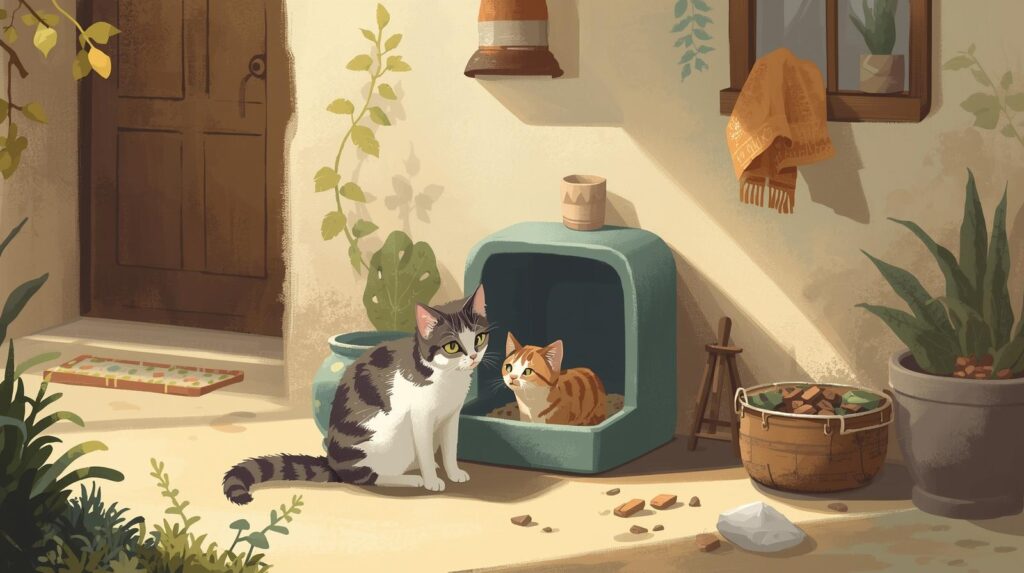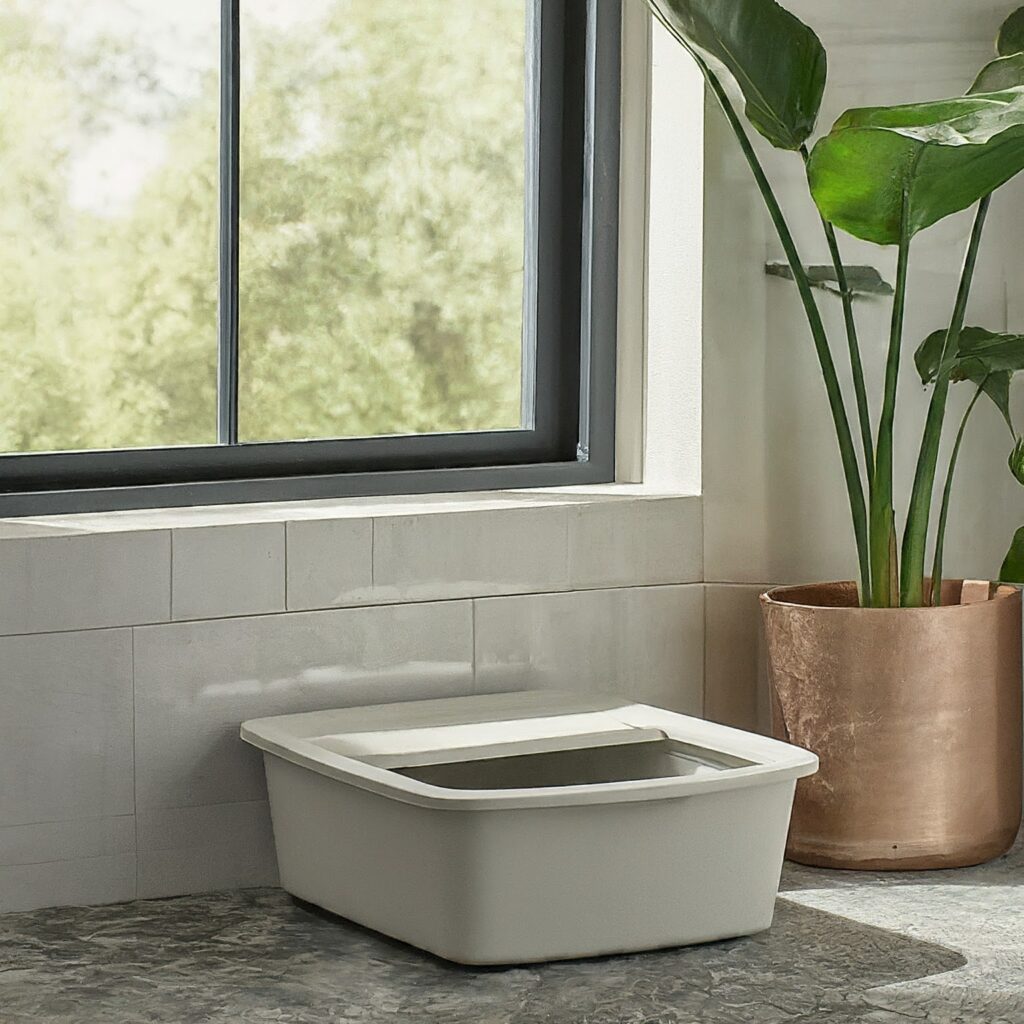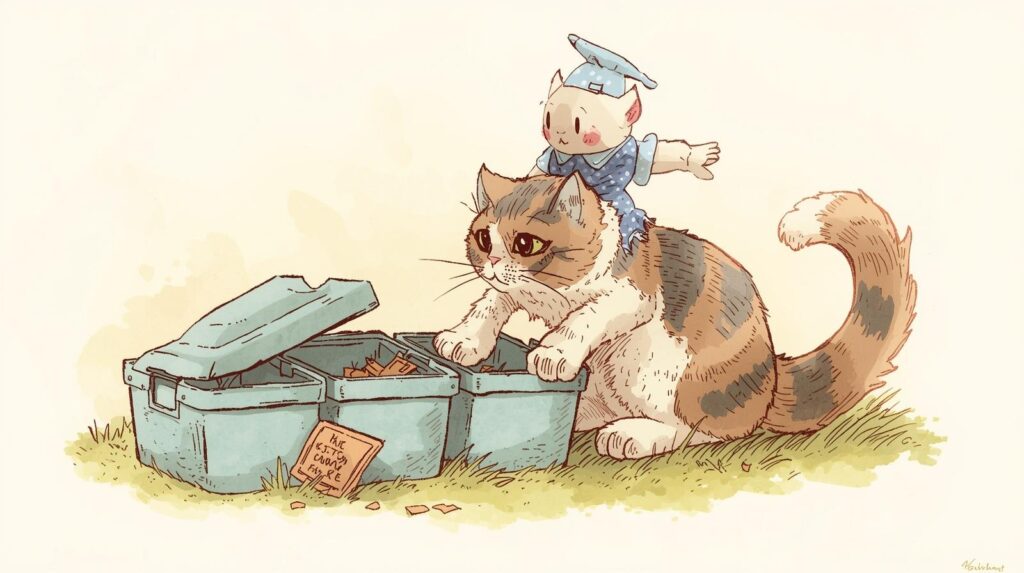
If you live with more than one cat, it’s natural to wonder, “Can two cats use the same litter box?” Short answer: It’s possible, but it is almost never recommended because cats view the litter box as territory, not just a toilet. Sharing it can quietly trigger stress, silent competition, and even hidden bullying between cats.
Most vets follow the “1 litter box per cat + 1 extra” rule because it gives each cat a safe space where they don’t feel watched, challenged, or pushed out. Even if your cats look friendly or bonded, they still rely on scent ownership to feel secure. When the scent-mapping gets confusing, tension builds — and suddenly accidents, spraying, or hiding begin.
So yes — Can two cats use the same litter box? They can, but long-term it often damages comfort, confidence, and emotional balance between cats. Some indoor or bonded cats may tolerate sharing, but very few truly prefer it.
In this blog, we’ll explore:
- how to prevent fights, pee accidents, or territory anxiety.
- What actually happens inside a shared litter box (behaviorally & emotionally),
- when sharing is okay vs when it becomes harmful,
- How to set up a stress-free multi-cat litter system
Table of Contents
What Happens If Two Cats Share a Litter Box?

When two cats share a single litter box, a quiet “territory battle” usually begins — even if you never see it happening. Cats don’t just use a litter box to pee or poop. They also claim it with their scent. This is how they tell other cats, “This belongs to me.”
If both cats are using the same spot, one of them often starts feeling watched, trapped, or outranked. That’s why many cats begin holding their urine, waiting for the other cat to leave the area, or avoiding the box altogether, which later turns into accidents on soft surfaces like beds, carpets, or laundry piles.
Common hidden effects of sharing include:
- One cat is using the box more confidently, while
- The other cat begins using it less (silent insecurity)
- Quick visits from the dominant cat
- Delayed visits from the anxious cat
- One scent claiming the space
- The other cat feels like a “guest” in its own home
Even if they aren’t physically fighting, mentally they’re still competing.
Why This Creates Stress
Most people think cats fight only with claws, but emotional territorial stress is invisible. It shows up as:
- hesitating before entering the box
- looking around nervously
- going at night when the other cat is asleep
- urinating just outside the box
- “holding it in” too long
When cats feel unsafe using the litter box, they stop seeing it as a bathroom and start seeing it as a threat zone.
This is why veterinarians advise caution before ever assuming it’s “fine” for two cats to use one litter box.
Will a Cat Use a Litter Box That Another Cat Has Used?
Yes — some cats will, but the bigger truth is: most cats don’t feel good about it. They may still use it, but they do so with hesitation, insecurity, or silent stress.
Cats communicate through scent. When one cat smells another cat’s urine or poop inside the litter box, it reads that message as:
“Someone else owns this space.”
A confident or dominant cat won’t care — they’ll just reclaim it.
But a shy, younger, anxious, or lower-ranking cat may start to avoid it.
That’s why multi-cat households often have one cat who pees inside the box…
and another who pees near the box.
Which Cats Will Share More Easily?
| Cat Type | Behavior |
|---|---|
| Confident / Dominant Cat | Shares but “claims ownership” |
| Easygoing / Passive Cat | Uses it quietly but stressed |
| Timid or Anxious Cat | Avoids or “waits” |
| Sick or Old Cat | Needs a private box |
| Previously bullied cat | Won’t share |
So while it may look like sharing is working, mentally, one cat may already be pulling away.
A Silent Sign Most Owners Don’t Notice
If your second cat waits for the first cat to leave the room before using the litter box, it means the second cat does not feel safe.
This is already the start of litter box stress.
Your cat may be using the box…
But it is not relaxed while using it.
Is One Litter Box Enough for Two Cats?

Most vets say no, one litter box is not enough for two cats. The general rule is called: “1 litter box per cat + 1 extra.”
So for 2 cats, the ideal number is 3 litter boxes.
This extra box is very important because it gives your cats a choice, not competition. When cats feel they must share, stress slowly builds, even if they never fight in front of you.
Why One Box Becomes a Problem
| Issue | What Happens |
|---|---|
| Territory | One cat “claims” the box |
| Stress | The shy cat stops using it confidently |
| Waiting | One cat hides or delays using the box |
| Accidents | Peeing outside the box begins |
| Vet Visits | Stress can lead to UTIs or constipation |
Some cats look like they are sharing “happily,” but really, the quieter cat is just tolerating, not choosing.
A Vet Tip:
When cats don’t feel safe in the litter box, they start to feel unsafe in the home.
The litter box is emotional territory, not just a toilet.
That’s why giving each cat its own private option prevents long-term conflict.
Can Indoor, Bonded, or Sibling Cats Share One Litter Box?
Many cat owners assume that if their cats are siblings, bonded, or live only indoors, then sharing one litter box should be fine. But even loving or friendly cats still need their own space when it comes to bathroom territory.
Bonded cats may sleep together, groom each other, or play side by side — but the litter box is different. It is a private comfort zone, not a shared toy or bed.
Can two indoor cats share one litter box?
Indoor cats are more territory-sensitive because they do not have outdoor space to release stress. When they share one litter box, one cat often becomes the “dominant user,” and the other cat quietly backs away.
So even for indoor cats, sharing is usually stressful in the long run.
Can bonded cats use one litter box?
Bonded cats may tolerate sharing better than strangers, but they still do not prefer it. Sharing one box can slowly create unspoken competition. One cat may start guarding the box or blocking access without the owner noticing.
Can sibling cats share a litter box?
Siblings can share temporarily when they are young, but as they grow older, they develop their own territory boundaries. A kitten may share happily for months, but once adolescence begins, they need privacy and independence.
The Key Truth
Just because two cats live together does not mean they want to share everything, especially something as territory-linked as a litter box.
They can share…
But they rarely feel safe sharing.
That is why most veterinarians still recommend separate litter boxes, even for bonded, sibling, or indoor cats.
Best Litter Box Setup for 2 Cats (Pro Tips)
When living with two cats, the setup matters just as much as the number of litter boxes. Even if you give each cat its own box, poor placement can still cause stress or fights. A good setup helps both cats feel safe, relaxed, and confident while using the box.
Below are the most vet-recommended tips for the best litter box layout for multi-cat homes:
1. Use the “1 Per Cat + 1 Extra” Rule
For 2 cats, the ideal setup is:
3 litter boxes in separate areas
—not next to each other in the same corner.
2. Keep Boxes in Quiet Places
Cats don’t like noise, sudden footsteps, or feeling watched while using the box.
Avoid placing boxes:
- next to washing machines
- in busy hallways
- near loud litter robots
- near doors with traffic
They should be in calm spaces where a cat can enter and exit without fear.
3. Never Line All Boxes Together
Some owners place multiple boxes side by side, thinking this counts as “more than one box.” But to cats, side-by-side boxes feel like “one big shared box” — not separate choices.
4. Give Each Cat a Clear Escape Route
Cats feel trapped if there’s only one way in and out.
That is why covered boxes can make timid cats nervous — they cannot see who might be waiting outside.
Open-top litter boxes are usually safer for sharing.
5. Keep Litter Boxes Far From Food and Water
Cats never want to eat and toilet in the same territory zone.
Placing them too close makes cats instinctively uncomfortable.
6. Match the Box to the Cat’s Size
A large or overweight cat may avoid a small box. The rule is:
longer than the cat’s body from nose to tail base.
Why This Setup Works
- A smart litter box layout:
- prevents territorial blocking
- gives each cat a true “choice”
- reduces stress and accidents
- keeps the home peaceful
Litter Box Sharing Mistakes Cat Owners Make
Many cat owners don’t realise that small setup mistakes can lead to big behaviour problems later. A cat may not fight today, but stress builds slowly and shows up as accidents, hiding, or litter avoidance weeks or months later.
Here are the most common mistakes people make when two cats live in the same home:
Mistake #1: Only One Litter Box for Two Cats
Even if the cats “seem fine,” one cat is almost always holding back or waiting for a turn. This is silent stress.
Mistake #2: Placing All Boxes Side by Side
When boxes are together, cats see them as one single territory, not separate options. This creates sharing pressure.
Mistake #3: Using Covered or Enclosed Boxes for Both Cats
Covered boxes can make shy cats feel trapped, watched, or ambushed on exit.
Mistake #4: Not Cleaning the Box Often Enough
Two cats create twice the waste. If the box is dirty, one cat will “give up” and start peeing elsewhere.
Mistake #5: Ignoring Body Language
A cat avoiding the box is not “stubborn” — it is uncomfortable.
Scratching the floor beside the box, peeking inside and leaving, or waiting are all warning signs.
Mistake #6: Thinking Bonded Cats Don’t Need Privacy
Even closely bonded cats have personal scent boundaries. Grooming together does NOT equal bathroom comfort.
Mistake #7: Only Adding Extra Boxes After a Problem Starts
By the time a cat begins peeing outside the box, stress is already high. Prevention is always easier than fixing.
How to Stop Cats from Fighting Over the Litter Box
Litter box fights don’t always look like loud attacks.
Sometimes the “fight” is silent — blocking the path, staring, waiting, or chasing the other cat away after they finish. To stop this, you must remove competition and give both cats safe access without pressure.
Here are the best ways to prevent or stop litter box battles:
1. Add More Litter Boxes in Separate Places
When each cat has its own “safe zone,” they don’t feel the need to guard or block the area.
2. Avoid Corners or Tight Spaces
If a box is in a corner, one cat can easily trap the other.
Boxes should be in open areas so the cat can escape freely.
3. Use Open-Top Boxes Instead of Covered Ones
A covered box can feel like a trap.
Open boxes give safety, visibility, and confidence.
4. Give Each Cat More Than One Way to Access the Box
If there is only one entry, a dominant cat can “guard” it.
A box in a wide, open space solves this.
5. Keep Litter Boxes Very Clean
If the box smells too strongly of one cat, the second cat may stop using it. Scooping twice a day helps both cats feel safe.
6. Provide Other Resources to Reduce Competition
Cats won’t fight for a litter box if they do not feel the need to “control” territory.
Add:
- more hiding spots
- separate feeding stations
- more than one resting area
- multiple scratching posts
When cats feel secure in daily life, they don’t fight over the bathroom.
7. Never Punish a Cat for Litter Box Problems
Punishment increases fear, which makes litter problems worse, not better.
The solution is always environmental change, not discipline.
What Happens If Cats Share a Litter Box Long-Term
If two cats use the same litter box for a long time, it may seem fine in the beginning — but over time, stress and hygiene issues usually build up. Cats are extremely territorial by nature, even if they are friendly siblings. Long-term litter box sharing can slowly create unhealthy habits and emotional tension.
Here’s what typically happens over time:
| Problem | What It Causes |
|---|---|
| Silent stress | Hiding, over-grooming, anxiety |
| Litter box avoidance | Peeing on carpets, beds, or corners |
| Territorial behavior | Guarding the box or blocking access |
| Hygiene issues | More smell, more bacteria, dirty paws |
| Health risk | Higher chance of urinary problems |
1. Growing Territorial Stress
Even bonded cats often want their own private bathroom space. When they can’t control it, they feel like part of their territory is being “taken.” This may first show up not as fighting, but as silent stress, where one cat becomes withdrawn or overly clingy.
2. Litter Box Avoidance
After a few months of forced sharing, many cats stop using the box regularly.
This leads to:
- Peeing in the hallway or on soft things like blankets
- Pooping just outside the box
- “Holding it” too long (which causes pain)
3. Health Issues Can Develop
The biggest long-term danger is UTI or bladder inflammation (FLUTD). When cats feel stressed or cannot reach the litter box freely, they delay peeing, which is unhealthy. Male cats especially can experience dangerous blockages, which is a vet emergency.
4. Household Odor & Cleanliness Problems
When two cats use the same litter box, the box fills twice as fast.
This causes:
- Strong ammonia smell
- Wet clumps sticking to the sides
- More bacteria and fungal growth
- Dirty paws spreading litter germs around the home
Vet-Recommended Litter Box Ratio for Two Cats
Veterinarians follow a very simple rule when it comes to multi-cat homes:
Number of cats + 1 extra = total litter boxes
This means:
| Number of Cats | Vet-Recommended Litter Boxes |
|---|---|
| 1 cat | 2 litter boxes |
| 2 cats | 3 litter boxes |
| 3 cats | 4 litter boxes |
| 4 cats | 5 litter boxes |
So if you’re wondering,
Can two cats use the same litter box?
Yes, but they shouldn’t rely on just one long-term.
Vet-recommended products for you
Further readings
Symptoms of ammonia poisoning from cat urine
How to get rid of flies in cat litter
FAQs- Can Two Cats Use the Same Litter Box?
Can two cats use the same litter box Reddit?
Yes — many owners on Reddit say their cats can technically share one box, but long-term, it causes stress. Even bonded cats still prefer choice. That’s why vets recommend one box per cat + one extra, not just one shared box. Sharing continuously can lead to silent territorial stress, which later turns into aggression or peeing accidents.
How many litter boxes for 2 cats?
For 2 cats, the healthy formula is:
2 cats + 1 extra = 3 litter boxes
This gives both cats privacy and prevents guarding or blocking behavior.
2 litter boxes side-by-side — is that OK?
No — placing two boxes side-by-side counts as ONE bathroom area, not two.
If one cat blocks the entrance, the second cat can’t escape. Place them in different rooms or far corners for true privacy.
Where to put litter boxes for two cats?
Ideal locations are:
Quiet corners (not hallways)
Away from loud appliances
Not near food/water bowls
Different rooms/levels of the house
Avoid tight spots where one cat could trap the other.
Why do my cats share a litter box if I have more?
Cats sometimes share because:
They are bonded or young
One box smells “familiar”
They prefer a certain litter texture or size
Placement makes one box more convenient
However, just because they do share doesn’t mean they should all the time. Backup boxes prevent future fights.
One litter box for two cats Reddit — is it really bad?
Yes — most behavior experts on Reddit and veterinarians agree that one shared box works for a short time but not long-term. Over months, it creates:
Resource guarding
Silent stress
Box avoidance
Sudden fighting
Urinary issues
It may look fine today, but tomorrow one cat might refuse the box entirely.
Wrap-Up:
The short answer is yes, two cats can share — but the healthy, stress-free, vet-approved practice is giving them more than one option. Cats are territorial by nature, and the litter box is one of their most emotionally sensitive resources. When there’s only one box, conflict slowly builds — even between bonded or sibling cats.
That’s why veterinarians recommend:
1 litter box per cat + 1 extra
For 2 cats → 3 litter boxes total
Offering choice keeps your cats:
- Calm
- Confident
- Territorial stress-free
- Less likely to fight
- Less likely to pee outside the box
It also protects their urinary health, which is the #1 reason cats end up at the vet.


